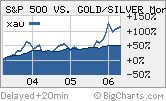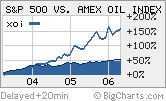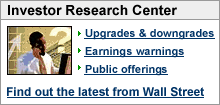|
Something's gotta give (for stocks)
Inflation signs are flashing all over Wall Street, and interest rates are rising. So why aren't stocks tumbling?
NEW YORK (CNNMoney.com) - Forget Goldilocks. Pollyanna's been running up and down Wall Street lately, annoying bears and bulls alike, and she doesn't seem to be getting tired - yet. Oil is back near $70 a barrel, gold is flirting with $600, a 25-year high, and the 10-year Treasury yield is back up near 5 percent, its highest in almost four years - all classic signs that some investors think inflation's about to make a comeback.
Yet stocks are doing just fine, considering, posting modest declines at most over the past few sessions. "The stock market is wobbling, but not tipping," said Douglas Altabef, managing director at Matrix Asset Advisors. In fact, the major gauges remain near multi-year highs and the Russell 2000 index of small-cap stocks is near its all-time high. Why is that? It may be that the factors lifting oil, gold and interest rates are also lifting stocks, said Stephen Leeb, president of Leeb Capital Management. "The rise in commodities, interest rates, all of this is a reflection of worldwide growth," Leeb said. "That's why the stock market is not crashing." The surge in gold prices - traditionally seen as a hedge against inflation - could also be a reflection of broader demand for the commodity around the world, Altabef said. As long as all of these other markets can keep rising, that should help support stocks, Leeb said. "The risk is if one of these markets became explosive," he said, that could upset the balance. So are stock investors just delaying the inevitable, or are there enough factors in place to keep stocks from sinking? The sky is falling
Surging oil prices, gold above $600 an ounce and rising rates could add up to a nasty environment for stocks, said Paul Mendelsohn, chief investment strategist at Windham Financial Services. And the market could be especially vulnerable if oil, gold and interest rates surge further, he said, noting that such an environment would be somewhat the opposite of what happened in 1982, the start of what the Stock Trader's Almanac calls the "super bull cycle" that stretched on and off until 2000. Inflationary pressures similar to now were in play in 1982, Mendelsohn noted, but receded gradually the next few years, enabling stocks to rise. The run up in long-term bond yields in recent weeks could be another big negative for stocks, since it means bond traders are betting the Federal Reserve will push short-term rates higher than had been anticipated. Stock investors are betting on one or possibly two more rate hikes from the Fed. But should yields keep rising, stock investors may have to start factoring in the possibility of more, which would be bearish for Wall Street indeed. "If inflation doesn't accelerate much from here, and the Fed just raises rates a little more, we might see something like the end of the 1990s again," said Stephen Stanley, chief economist at RBS Greenwich Capital. "But if the Fed has to really ramp up to fight inflation, it's going to be a much worse environment than investors realize." The sky is not falling
"Why all the gloom?" asked Peter Brodie, director of investments at Bryn Mawr Trust Wealth Management, noting that yes, the stock market is vulnerable, but nevertheless remains well supported since corporate earnings growth has managed to stay strong. Alcoa (Research) rallied after kicking off earnings season with strong results Monday but that had little impact on the broader market. Still, first-quarter earnings overall are expected to rise about 11 percent from a year ago, which would be the 11th straight quarter of growth of at least 10 percent. Stocks are also getting some support as money that had been going into real estate is starting to flow back into stocks, Brodie said. There have been numerous signs in recent months that the real estate market is cooling - and what's bad for the goose is sometimes good for the gander. For example, as long as oil prices stay strong but don't surge too much, that seems to be OK for the broader stock market and bullish for oil stocks. Oil prices have been rising for three years and so far that hasn't caused the economy to go into a tailspin. Additionally, the "the fact that interest rates are going up is not necessarily bad for certain stocks, such as select financials," Altabef said. And the rally in small stocks might mean that big caps' day in the sun is still on the horizon, he added. What about the surge in the 10-year note yield, which has flirted with 5 percent recently? The threat is that if long-term yields rise a lot more, investors could shift money to bonds from stocks. But the rally in long-term yields has also helped return bond market rates to a more normal pattern, which is a plus for stocks, Mendelsohn at Windham Financial Services said. In recent weeks, yields on shorter-dated Treasuries were above those on longer maturities, a so-called inverted yield curve that has in the past spelled troubled for the economy. But that's been reversing over the last few weeks. Finally, the bulls may be able to hang on longer simply because they've been hanging on so long. Stocks have more or less been in an uptrend since bottoming in October of 2002. "The stock market tends to rise," Mendelsohn said. "And once it has been in an uptrend, you really need something big to get it to move substantially lower." ---------------------------------------------------- Need an investor's road map for the second quarter? Click here. The next six months could still be tough. Full story.
What's ailing big cap stocks? More here. |
|






